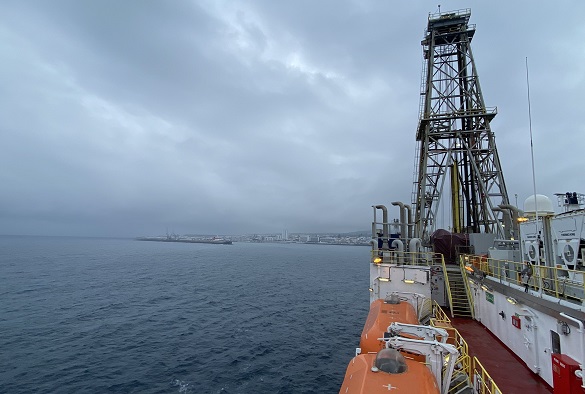University of Liverpool expert a part of international expedition to study Reykjanes Ridge
Dr David McNamara, an Earth scientist from the School of Environmental Sciences, is part of an international research expedition that will collect and analyse drill samples of lava and sediment from the deep waters South of Iceland in order to better understand how processes deep in the planet’s interior effect oceanic currents, seafloor chemistry, and past climate.
A structural geologist and mineralogist, Dr McNamara is one of the team of scientists on board the International Ocean Discovery Program Expedition 395 that has set sail to the flanks of the Reykjanes Ridge, where the Mid-Atlantic spreading centre, the Iceland mantle plume, and deep-water currents interact.
Figure 1 (above): Bathymetry, deepwater current (dashed lines), contourite drifts (grey shading), Seismic Profile JC50-1 (solid line), and Expedition 395 and 395C sites
JOIDES Resolution
The team are on board the JOIDES (Joint Oceanographic Institutions for Deep Earth Sampling) Resolution, a scientific research vessel that drills into the ocean floor.
During this expedition, the JOIDES Resolution will be drilling six sites in water depths ranging from 1,415 to 2,209 meters for rock samples that the scientific team can immediately analyse in the laboratories onboard the vessel.
Dr McNamara’s scientific expertise centres on fluid flow in the Earth’s crust and how this can affect geothermal resources, the formation of mineral deposits, or earthquake behaviour.
His role on the Expedition will be to investigate the mineralogy and structure of the drilled sediment and lava samples. This will allow him and his colleagues to determine how seawater and seafloor rocks physically and chemically interact over millions of years.
Two photos of Dave McNamara taken on board OJIDES Resolution
Dr McNamara said: “I am very excited to be part of this international expedition. To get to work with a diverse group of geological and biological experts from all over the world is an amazing career and scientific opportunity, and I cannot wait to see what we find and hope that the samples and data we collect will help us understand how chemical interactions within the seafloor contribute to natural cycles of carbon and other elements”
“During my time away, I will mainly be responsible for analysing digital data we collect from special tools lowered into the holes we drill, as well as describing and cataloguing the rock samples we collect in the ship’s labs. I am also excited to bring some of these rock samples back to Liverpool to study their chemistry and crystallography at our Scanning Electron Microscopy Shared Research Facility. I hope that the samples and data we collect will help us understand how chemical interactions within the Atlantic seafloor contribute to natural global cycles of carbon and other elements, as well as provide new insights into how minerals form and grow in these geological systems.”
Image: The JOIDES Resolution credit International Ocean Discovery Program (IODP)
Reykjanes Ridge
The Reykjanes Ridge is located at the top of the Mid Atlantic ridge, just below Iceland, and is home to a giant intersecting mantle plume-spreading ridge system. The area is unusual because of a series of time-transgressive V-shaped ridges and troughs.
The flanks of the Reykjanes Ridge are blanketed by rapidly accumulating sediments that record the oceanographic conditions under the influence of nearby deep-water gateways. This configuration provides an ideal natural laboratory to test a diverse range of hypotheses about mantle dynamics, crustal accretion, paleoceanography, hydrothermal alteration, and climate.
IODP Expedition 395
IODP Expedition 395 involves 30 scientists from 9 countries, with expertise in a range of geoscience and biological disciplines. It set sail on June 13th and the expedition will last for eight weeks, during which the scientists and the ship’s crew will be at sea for the entire time, living and working.
The expedition is led by Co-Chief Scientists Anne Briais (CNRS, France) and Ross Parnell-Turner (Scripps Institution of Oceanography, USA).
The analyses from the expedition will be made available to non-expedition scientists after a one-year moratorium. Data from these core samples will be used by scientists all over the world.
The IODP is a multidecadal, international research program supported by 21 nations, with the goal of exploring Earth’s history and structure recorded in seafloor sediments and rocks and monitoring sub-seafloor environments.
Dr McNamara is supported on the expedition by the Natural and Environmental Research Council (NERC), UK.

